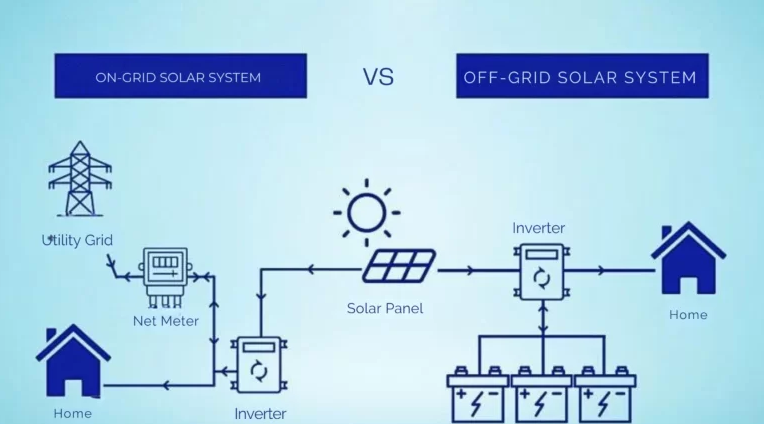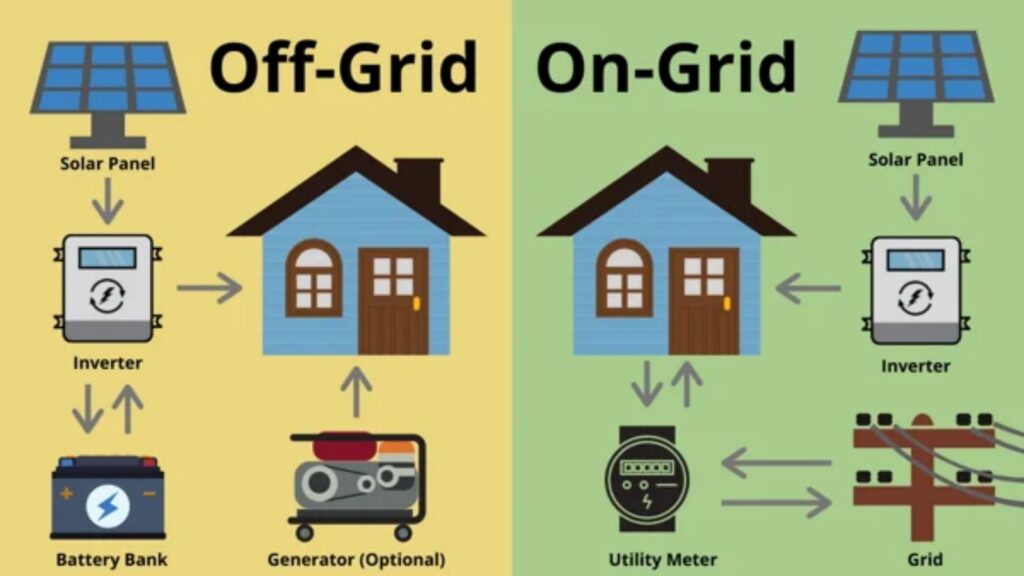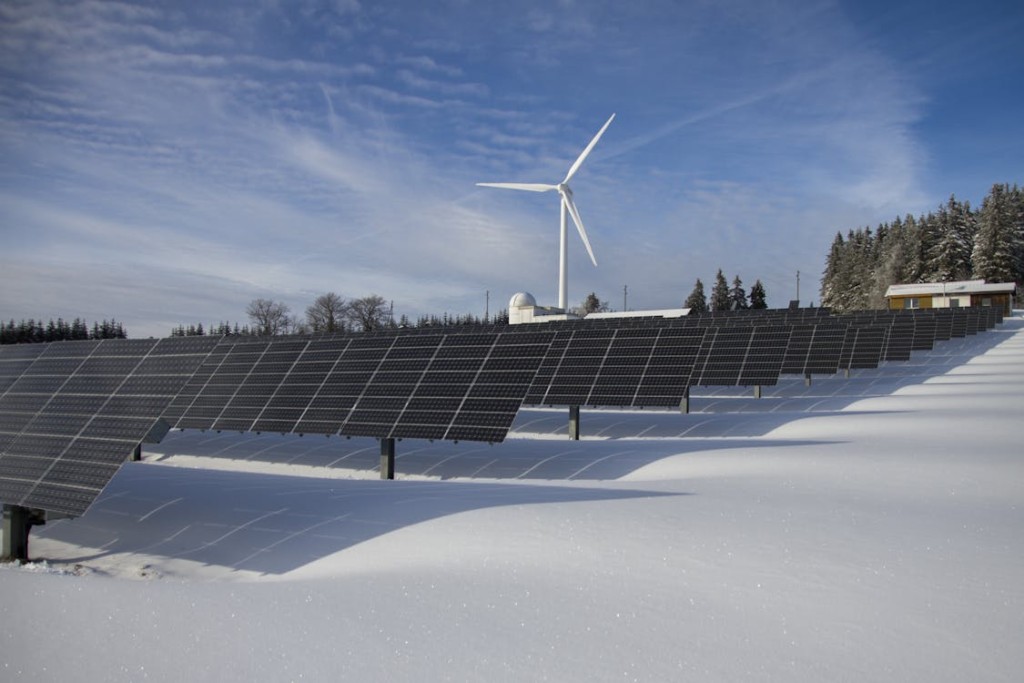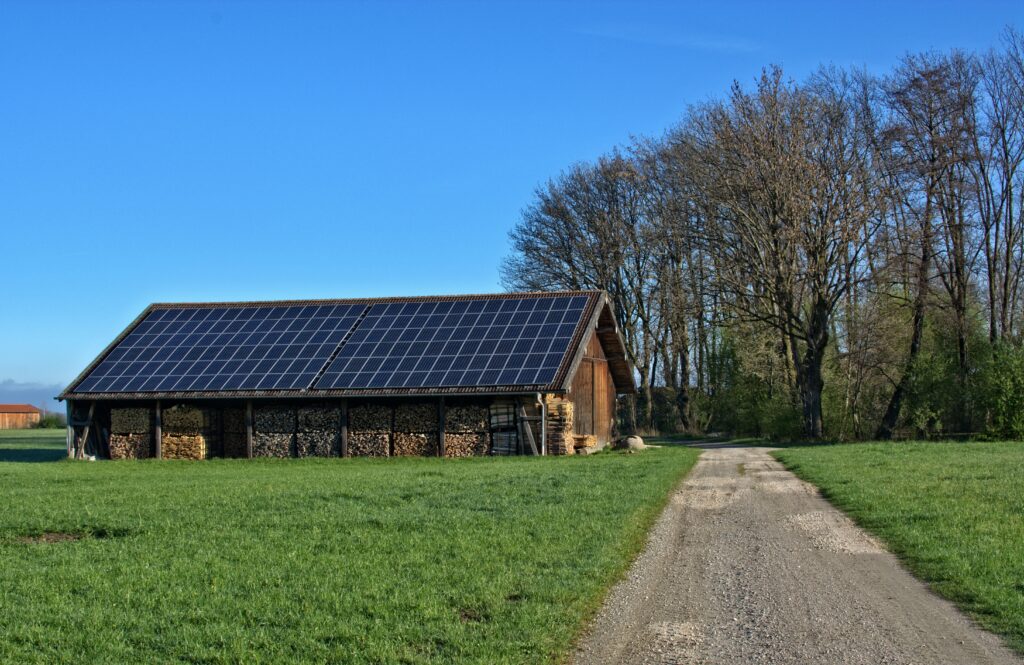On-grid Photovoltaic Solar System :
1. System Components and Working Principle
- Solar Panels:
- Solar panels convert sunlight into direct current (DC) electricity through the photovoltaic effect. They are usually installed in places with abundant sunlight, such as rooftops or open areas. Common types include monocrystalline silicon and polycrystalline silicon solar panels.
- PV Combiner box:
- It is an essential electrical component in solar power systems that combines the output of multiple solar panel strings into a single consolidated output, which is then connected to an inverter or charge controller.
- Inverter:
- It plays a crucial role in transforming the DC electricity generated by solar panels into alternating current (AC) electricity that meets the requirements of the grid, enabling it to be smoothly integrated into the grid. There are different types like centralized inverters and string inverters available in the market, which are selected according to specific application scenarios.
- Distribution Box (Optional):
- It is used to distribute and protect the circuits within the system, ensuring the safe and stable operation of each part of the circuit by properly managing voltage, current, etc.
- Bidirectional Electricity Meter:
- It accurately measures the electricity generated by the photovoltaic system and the electricity exchange between the system and the grid. It records both the surplus electricity sent to the grid and the electricity taken from the grid, facilitating electricity bill settlement and other matters.

2. Advantages for installing an on-grid photovoltaic system
- Electricity Cost Saving:
- When there is sufficient sunlight and the electricity generation is greater than the on-site consumption, the surplus electricity can be sold to the grid when the regulation allows in the country, bringing economic benefits and reducing the overall electricity cost. For example, in a household, the surplus electricity can be fed into the grid during the day, while covering also the consumption of the load, and then to use electricity from the grid at a lower price at night during off-peak hours
- Stable Power Supply:
- When solar power generation is insufficient, such as on cloudy days or at night, electricity can be obtained from the grid to ensure a continuous and stable power supply without power interruption
- Relatively Simple Maintenance:
- Compared with off-grid systems, it doesn’t require complex maintenance of energy storage equipment. Regular maintenance mainly involves cleaning solar panels and inspecting inverters
3. Limitations
- High Dependence on the Grid:
- Once there is a grid failure, such as power outage for maintenance or line failure, even if the solar panels are working properly, normal power supply may not be possible. Additional backup power sources, such as a battery energy storage system, are needed to ensure electricity supply
- Strict Grid Connection Requirements:
- Varies from country to country, the PV system must comply with various technical standards of the grid regarding voltage, frequency, power quality, etc., as well as relevant policies. The design, installation, and commissioning in the early stage require professional operation also to ensure a smooth connection to the grid

Off-Grid Photovoltaic System
1. System Components and Working Principle
- Solar Panels:
- Just as in the grid-connected system, they convert solar energy into DC electricity, providing the energy basis for subsequent electricity use
- Battery:
- It is the core energy storage component. It stores the surplus electricity generated by solar panels during the day so that it can supply electricity to electrical equipment when there is insufficient sunlight or no sunlight, such as lead-acid batteries and lithium batteries
- Inverter:
- It converts the DC electricity output by the battery into AC electricity to meet the usage requirements of various AC electrical appliances, such as lighting fixtures, televisions, and refrigerators
- Controller (if not provided in inverter):
- It effectively regulates the DC electricity output by solar panels. For example, it controls the charging current and voltage to prevent overcharging or over discharging of batteries, extend the service life of batteries, and ensure the stable operation of the system

2. Advantages for installing an off-grid photovoltaic system
- High Independence:
- It is especially suitable for remote areas that are not covered by the grid, or lack of electricity, such as solitary cabins in deep mountains or remote islands. An off-grid solar system can provide basic electricity guarantee for local residents, scientific research stations etc., achieving self-sufficiency in use of electricity
- Flexible Configuration:
- It is more flexible in choosing the capacity of solar panels, batteries, and other solar system units according to the actual electricity consumption and budget, providing a high level of customization
3. Limitations
- High Cost:
- Batteries are costly, and they need to be replaced as time goes by, increasing the long-term use cost of the system. The overall initial investment is also larger than a grid-connected system
- Limited Energy Storage:
- The energy storage capacity is limited. If experience insufficient sunlight for a long period of time, such as continuous cloudy days, or if the power consumption of electrical appliances exceeds the designed capacity, there will be a shortage in electricity, which would affect the daily operations
- Maintenance related:
- Maintenance is required regarding the state of batteries. The normal operation of controllers, inverters, and other system components also need to be monitored in a regular basis. Thus, compared with the grid-connected system, the workload and technical requirements for maintenance are higher

The Area of Application for On-grid PV Solar Systems:
Residential areas: Many households install them on rooftops to reduce electricity bills by using solar power generated from sunlight during the day and then switch to grid when needed. It’s convenient as they could always ensure a consistent power supply while having the grid as a backup.
Commercial buildings: Such as offices, shopping malls, small workshops and factories. A PV system can well ensure a good coverage of their daily electricity demand during business hours, and transfer excess power back to the grid. The system is environmentally friendly and can bring long-term economic benefits to the business owners.
Industrial parks: To power various manufacturing processes with green energy and reduce reliance on traditional grid electricity, which helps to cut effectively the electricity costs and achieve sustainable development goals.
Off-grid PV solar systems are mainly used in the following scenarios instead:
Remote rural areas: In some villages or small settlements that are far from the main power grid, or regions with a shortage in electricity supply during the day, off-grid solar systems can provide basic electricity for lighting, charging small electrical appliances, and powering communication devices.
Remote cabins and camps: For people staying in mountain cabins or camping sites without grid access, these systems can supply basic power for living needs, like lighting and small electrical appliance.
Isolated islands: Where it’s difficult or costly to connect to the mainland grid, off-grid solar systems are then becoming crucial for powering local community and some essential facilities.

Fix an appointment now ! with our expert consultant team for an overview of our collections, and also our best propositions of solar energy system solutions, for your residential, commercial, and industrial needs.
Content editor: Pela Li
Email contact: pela.li@moreday.com
WhatsApp: +86 189 6876 6150
MOREDAY, more than solar
An expert manufacturer team based in South China, for both on-grid and off-grid, high and low voltage PV solar energy management unit, AC DC EV chargers, and prefabricated transformer substations. Unique customized solar system solution provider, offering dedicated battery energy storage solutions for up to 3MW system and 7.2MWh storage.
🌎🌍🌏 Moreday, for a better and more sustainable future !
#moreday #NewEnergy #photovoltaic #solar #greenenergy #ongrid #offgrid #sustainableliving







